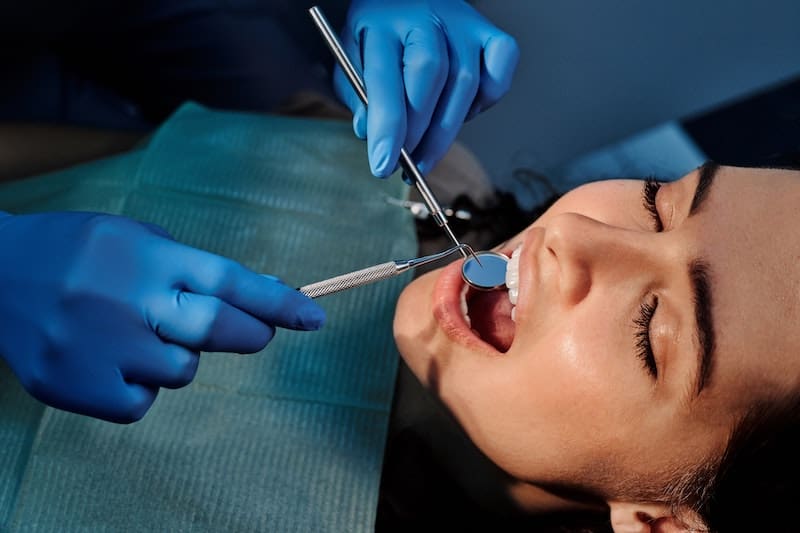
30 Oct How Can You Tell If A Filling Is Bad?
How to Tell When You Need to Replace Your Filling
Do you have a dental filling that suddenly starts hurting after many years of not causing any trouble? Are you worried about the dentist bill because you don’t know for sure if your filling even needed to be replaced? This is a common concern of many of our patients.
So, how can you tell if a filling is bad? There are many signs that your filling may need to be replaced. Some of these include sensitivity to hot or cold food or beverages, an uneven surface, cracking, chipping, or decay around the filling, a broken tooth again, shifting of a tooth’s position, or a change in the color of a tooth after it has been filled.
Keep reading to learn more about why fillings are important, and some of the warning signs you should look out for if you have fillings in your teeth.
What is a Dental Filling?
To better understand your situation, it’s best to think of a dental filling as a protective seal over the root canal.
Dental fillings are an important part of your dental health. They help protect sensitive areas from the outside environment, and can lead to tooth decay beneath or root canal infections if they come loose!
Many other symptoms are possible indicators of an issue. If you happen to have them before going for any dental cleaning or work done on their tooth/teeth at least once every six months, there is no doubt that something must be wrong with your teeth and gums.
Some warning signs that may indicate oral problems include:
- Pain during hot or cold experiences,
- Very sensitive teeth when exposed to temperature changes,
- Bleeding gums due to brushing damage if not taken care of properly.
If this sounds like something you are dealing with, then some quick ways can help determine if your filling is bad.
Pain
The first way involves feeling the filling itself. Your dentist may have told you not to worry too much about it while the tooth was still open but now that it is closed again, try pressing on your tooth around where your filling is located.
You should feel nothing. If there’s pain involved in either pressing down or just touching the area, then it could mean that somehow fungus has gotten into your filling and the dentist needs to replace it.
Fractures or Discoloration
 You should consider having dental fillings replaced if you see tiny fractures in the material, notice any visible gaps forming between the filling and your tooth, or if you detect discoloration where it meets your natural tooth.
You should consider having dental fillings replaced if you see tiny fractures in the material, notice any visible gaps forming between the filling and your tooth, or if you detect discoloration where it meets your natural tooth.
To tell whether or not a tooth filling is bad, you should remember some simple steps:
- First of all, if the filling has changed color or consistency, it may be ill. If the filling has begun to turn green (due to oxidation) or become particularly slimy (due to bacterial growth), it’s time for a trip to your dentist’s office!
- On the other hand, if the filling is solid and still maintains its original color, it’s important to inspect the look and feel of the filling. If there are any cracks or holes in the tooth filling, bacteria may have begun to grow underneath, causing decay below your dentist’s eye-line.
- Bacteria can also be detected by smelling your tooth filling. If the filling smells bad, impacting the smell of your breath, it’s time to see your dentist.
- Lastly, if all else fails and you just aren’t sure about that tooth filling anymore, you can always try scraping off a bit of the tooth filling. If there are any grey or black particles on your fingernail after scraping, you should consult with your dentist as soon as possible!
Remember, if any of your tooth fillings are causing you concern, always consult with your Tulsa dentist. Your dentist will be able to tell you for sure whether or not the filling is bad and provide treatment options for bad fillings.
Dental Filling Options
There are several types of dental fillings that your dentist may offer. These include the following:
- White or amalgam restorations: silver/mercury alloy, 50% mercury content.
- Composite fillings: man-made material [the article says “synthetic material” but that can be confusing], made to look like natural tooth enamel.
- Gold fillings: 75% gold, 25% other metal(s)
Different Types of Dental Fillings
So, what’s the difference between gold, amalgam, and composite fillings? This is a common question that many people ask. The answer to this question depends on what you want out of your dental filling.
If you are looking for tooth-colored fillings, which look like natural teeth, then amalgam or composite fillings are best for you. If you are looking for an inexpensive option with lasting durability, then gold is probably the best choice.
Amalgam Dental Fillings
Amalgam (or silver) fillings provide a strong base for your teeth because they bond directly with the enamel. It is made up of silver mixed with mercury and other metals that strengthen its structure. This makes it last longer than any other type of filling.
Amalgam fillings usually last about eight years. This means that you need to replace them every eight years or so if they get worn down. Mercury is the main problem with amalgam fillings because mercury can be extremely toxic.
It has also been linked to memory loss and Alzheimer’s disease. For these reasons, you should avoid eating or drinking hot liquids after getting an amalgam filling.
Composite Dental Fillings
Composite (or white) fillings are made of a resin material and contain small glass particles for white coloring. This type of filling is mainly used on front teeth where aesthetics matter most. This is because it holds up well against impacts and looks very natural compared to other types of materials used for dental fillings.
Composite fillings also come in a variety of shades and can be custom-matched to blend with your teeth, making them the most natural-looking type of dental filling. They are less durable than amalgam dental fillings and need to be replaced every five years if they get worn down.
Gold Dental Fillings
If you want a dental filling that lasts longer than composite or amalgam ones, then opt for gold. It is more expensive but it can last up to 20 years, which means you only have to replace it every 10 – 15 yearly checkups at the dentist’s office. A drawback is that some people cannot afford gold fillings, so it may not be an option for everyone.
The choice between gold, amalgam, or composite fillings is ultimately up to you. The durability, affordability, and appearance should all be taken into consideration when choosing a dental filling for your teeth.
You can talk to your South Tulsa Dentist about which type of dental filling would work best for your smile!
What to Expect During a Filling Replacement
 Fills can be replaced through a straightforward and convenient treatment at our office. If they wear down or become loose, we offer you an easy way of getting your old filling out and replacing it with a new one to protect your tooth.
Fills can be replaced through a straightforward and convenient treatment at our office. If they wear down or become loose, we offer you an easy way of getting your old filling out and replacing it with a new one to protect your tooth.
Fillings are also one of the most common procedures done by dentists so there’s nothing to be anxious about! A dentist will replace a broken-down filling with an intact one to keep your mouth safe from further decay.
Length
This procedure is usually completed by a dentist in about 30 minutes. After the procedure is done, there are some ways to take care of the area so it can heal with proper oral hygiene procedures.
Discomfort
There is usually some level of discomfort when getting fillings done but this differs per person. Your dentist may give you an injection before they proceed with the procedure to numb the area being worked on. If you’re particularly sensitive, just let them know beforehand so they can take extra care in making you comfortable.
Healing
After the filling replacement, your mouth may feel a little sore and you might experience some bleeding due to the broken-down tooth tissue coming off. To relieve this sensation, it is recommended to rinse your mouth with warm salt water until the feeling subsides. It will help reduce any swelling and allow for comfort while eating food until the pain subsides.
This should heal within 3 days after your appointment. Your dentist will inform you about what painkillers you can take to lessen the discomfort.
Taking Care of Your Dental Filling
The next step in caring for your dental filling is to avoid any foods that may damage it. This includes avoiding certain fruits and vegetables such as apples, oranges, and carrots.
If the filling is exposed to too much sugar or acid, then it can decay and need to be replaced by a dentist. It is recommended to stick with soft foods because the filling is still very sensitive during this time period.
 After leaving the dentist’s office, get in the habit of brushing at least twice a day (or after every meal) using anti-bacterial toothpaste and warm water to reduce bacteria growth for up to 24 hours.
After leaving the dentist’s office, get in the habit of brushing at least twice a day (or after every meal) using anti-bacterial toothpaste and warm water to reduce bacteria growth for up to 24 hours.
This will help reduce any chance of infection around your dental repair work.
To make it more convenient, consider purchasing an electric toothbrush that has a built-in timer to help you brush for the recommended two minutes.
You should also stay away from tobacco products and alcohol during this time period because they can discolor your teeth, stain your gums, and cause damage to your enamel.
To determine whether your filling needs to be replaced, you can book an appointment at Magnolia Family Dental Care online or call.


Sorry, the comment form is closed at this time.